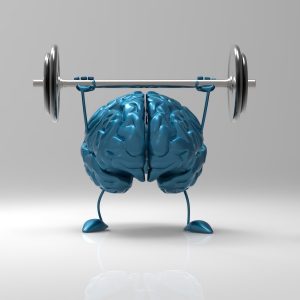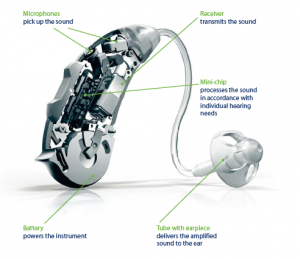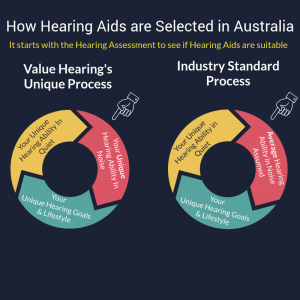Time to Read: 25 minutes
I was recently asked this exact question by a prospective client, who has had no previous experience with the hearing industry.
After giving it some thought, I realised that this is actually quite a good question and one that passes someone with years of experience in the industry by, as we often are blinded by our own common knowledge. This “common” knowledge is, however, not always common to anyone outside the industry, which makes this question a good one.
So in a quest to remove my blinders and answer the question so many people surely would have, I have written this article to answer this question to the best of my ability.
To understand the answer, you need a bit of context...
- Hearing aids help your brain more than your ears
- Difficulty hearing speech in noise
- How hearing aids work
- Okay, but how do I know if a hearing aid will work for me?
- Can’t I just trial an aid to see if it works?
- What are my other options?
Hearing Aids Help your Brain more than your Ears
When you think of human hearing, you need to consider that the ear with its little bones and snail shell shaped inner ear (cochlea) simply acts as a highly advanced microphone for the brain. This “microphone” delivers a signal to the brain for interpretation. It is the brain that wires itself based on the incoming signal (the sound from your ear) in order to make sense of the signal (sound) .
Each person dev elops their own unique way of processing sound in the brain (auditory processing). For instance musicians are able to process pitch information much better and in more detail than non-musicians. Similarly, people who worked and communicated in noise for years, tend to be better able to filter out background noise while listening to speech.
elops their own unique way of processing sound in the brain (auditory processing). For instance musicians are able to process pitch information much better and in more detail than non-musicians. Similarly, people who worked and communicated in noise for years, tend to be better able to filter out background noise while listening to speech.
When you have the most common type of hearing loss, called sensorineural hearing loss or nerve deafness, then essentially the “microphone” to your brain is damaged. This means that some sounds are not reaching your brain at all, while others are distorted and others still are heard perfectly fine. The brain again does what it does best and adjusts to this changed signal, disconnecting some “wiring” that is not being used in order to save energy. The brain then also starts relying more on non-sound cues to help with speech understanding. Things like lipreading develop naturally to fill in the missing pieces of sound, which is why some people feel they hear better with their glasses on and others complain that they could hear their partner if they would just not speak while walking away from them. Remember, hearing loss develops gradually, so these changes gradually takes place over years. As such it takes a while to first notice hearing loss.
So untreated hearing loss, depending on the type and severity, can affect hearing in quiet but more often also in noise.
Difficulty hearing speech in noise
Sensorineural hearing loss often causes difficulty understanding speech in noise because in a large number of people with this kind of hearing loss, the ability to hear low pitched sounds is generally better than their ability to hear high pitched sounds. This is called a sloping loss or high frequency hearing loss, which is by far the most common type of hearing deterioration.
When you can hear low pitch sounds better than high pitched sounds, you are generally able to hear volume and noise better than the sounds that give clarity to speech (sometimes called tone deafness). This also often makes you feel like others are mumbling, when they are in fact not (or at least not as badly as you hear them).
You can often do okay in quiet situations with this kind of loss, as long as the person is close enough and facing you, but hearing and understanding speech in noise is a different matter. What tends to happen in noise is that the better part of your hearing, the low pitch part, is drowned out (masked) by the noise which is mainly concentrated in the low pitch. This also happens in people with normal hearing, but we can also hear the high pitched sounds, which contains fragments (harmonics) of the drowned out speech. So with normal hearing you can fill in the gaps much better as there is redundancy. Normal hearing listeners essentially have more cues in reserve which their brains can refer to when the environment becomes challenging.
There is also a difference between individuals as to how well they could understand speech in noise, even if no hearing loss existed. This is called auditory processing as differs greatly between people depending how their processing skills developed. Things like childhood ear infections and genetics as well as school and work environments could play a role. We have an article here dedicated to help you find a solution that will work in quiet and noise.
How Hearing Aids work
Hearing aids essentially consist of a microphone or two, a computer chip loaded with software dedicated to processing sound, a battery and a speaker. It takes the sound before it enters your e ar and alters it, based on the programming done by the clinician and the software contained on the chip, to correct for your hearing loss. The sound is then passed into your ear canal, mixed with the natural sounds you naturally hear well. This “Corrected” sound then passes through your damaged ear (“Microphone”) to the brain. The brain then has to learn to interpret the sound again, which was lost over years of not hearing properly.
ar and alters it, based on the programming done by the clinician and the software contained on the chip, to correct for your hearing loss. The sound is then passed into your ear canal, mixed with the natural sounds you naturally hear well. This “Corrected” sound then passes through your damaged ear (“Microphone”) to the brain. The brain then has to learn to interpret the sound again, which was lost over years of not hearing properly.
Pretty much all hearing aids are able to improve your hearing in quiet. Even the most basic models can perform as well as the most expensive if there is no noise present. Where they do differ is in how well they can clean noise out of the sound before putting the sound back into your ear canal. Some can clean up a lot of noise, while others only clean up a little. If you are interested you can read more on the must have hearing aid features here.
The fact that you are “fixing” your brain, rather than your ear, is critical in understanding why people who wear their hearing aids more frequently, even in quiet when there is no-one around, do better than those who only wear it when they think they need it.
Okay, but how do I know if a hearing aid will work for me?
The short answer is that you should undergo a comprehensive hearing test that not only evaluates your ability to hear speech in quiet with correction, but also your corrected ability to understand speech in noise. Unfortunately, hearing loss corrected speech in noise testing is not part of the standard test battery and very few clinics commonly use this test.
When your hearing is tested, we want to find out how much damage is in the inner ear, using a simple beep test. Importantly, we then look at how well you are able to hear speech in quiet when things are made loud enough for you to hear despite your hearing loss. This gives us your maximum speech discrimination score. This score is shown as a percentage and tells us what percentage of speech you should be able to understand, in quiet, with properly fitted hearing aids. Pretty much any decent clinic includes this testing as standard.
Without understanding how well you are able to do with corrected hearing loss, in background noise, a lot is left to chance. As each person’s ability to hear in noise is unique to them, based on how their brain’s processing has developed over years, you cannot assume anyone is average. Ironically, this is what is commonly assumed in the industry, and this in turns leads to more expensive hearing aids being recommended that what is required. Similarly, it could also lead to less than optimal hearing aids being recommended when you actually need a lot more help than the average to hear speech in noise.
The speech in noise test consists of a number of short sentences, turned up to correct for your loss, played with increasing background speech babble with each sentence. You then have to repeat the sentences, guessing if you aren’t sure. Note: This test can only be accurately performed on people with a reasonable English speaking ability and with normal hearing through to moderately-severe hearing loss.
The tests gives you a score showing the  amount of signal to noise ratio loss you suffer expressed as a figure e.g 7.5dB. Every 3 dB above 0 dB, indicates that you need the speech twice as loud as the noise, compared to what a normal hearing person would require for the same situation. So to put it another way. If you had a 7.5 dB SNR Loss then you would need the speech to be about 6 times louder than the noise, to be able understand what is being said. A normal hearing person would be able to hear when speech and noise is more or less equally loud.
amount of signal to noise ratio loss you suffer expressed as a figure e.g 7.5dB. Every 3 dB above 0 dB, indicates that you need the speech twice as loud as the noise, compared to what a normal hearing person would require for the same situation. So to put it another way. If you had a 7.5 dB SNR Loss then you would need the speech to be about 6 times louder than the noise, to be able understand what is being said. A normal hearing person would be able to hear when speech and noise is more or less equally loud.
This figure is important, as each person is unique and different hearing aids have different capabilities to correct for background noise.
The clinician should match your hearing loss graph (audiogram), your speech in quiet results, as well as your speech in noise results, to a hearing aid that is best suited to all three results.
Doing this ensures that the hearing aid selected for you has a 94%+ chance of being the correct first choice.
As mentioned, most of the industry base their hearing aid selection process on your audiogram, speech in quiet result and your lifestyle. When lifestyle is used, the assumption is made that you have an average hearing ability in noise. This makes over-prescription quite common, as most people live active lifestyles, which is when the lifestyle selection method would indicate premium hearing aids. Ironically only about 30% of those active people would be shown to require top end expensive hearing aids if speech in noise testing, combined with hearing aid matching was used.
Can’t I just trial an aid to see if it works?
Hearing aid trials are often designed with one thing in mind. To sell top end hearing aids. That is why most demo hearing aids are the best version that that supplier has to offer (there are some exceptions). You will often see ads saying we need 25 people to trial the latest high tech hearing aid - BEWARE.
At best, a short term trial can be considered purely as a proof of concept, rather than an exact representation of how a hearing aid will work for you over the long term. So if you want to know whether you can tolerate something in your ear, but don’t mind that the trial device might not be the same as the actual hearing aid, then a trial might be an option.
Here is a short list of the issues I have with Short Term Trials:
- Your brain does not have enough time to really adjust to the sound - you need around 30 to 60 days to get somewhat adjusted and most trials last only a week or two.
- Trials don’t generally allow for fine tuning - as you wear a hearing aid that has been set to average settings, things might come to light that require tweaking. Short term trials generally don’t allow for extra appointments to address these issues.
- Trials rely on the “Honeymoon” effect to give you a more positive impression - trials are designed to sell hearing aids. The first few weeks of being able to hear much better than you were before you got the trial aids are generally very optimistic. After that your brain starts adjusting and you start noticing not only the good but also the less good aspects. Trial periods tend to be limited to the time that you are most enthusiastic, whether by design or coincidence.
What are my other options?
See if you can find a clinic that offers at least a 30 days or more FULL Money Back guarantee (we offer 60 days). This way you can wear the exact aid you have been recommended, have it ad justed as you get used to it and know exactly what you will be ending up with. It also gets you past the honeymoon period while allowing you time to comprehensively evaluate the hearing aid performance in a wide range of situations.
justed as you get used to it and know exactly what you will be ending up with. It also gets you past the honeymoon period while allowing you time to comprehensively evaluate the hearing aid performance in a wide range of situations.
Yes, it does require an upfront payment, but we have found that this actually helps rather than hinders the process. This is because you have skin in the game and actually do what is required to get the best outcome. The clinic is also incentivised to make the device work for you in order to avoid a costly refund (they don’t just lose the sale but also the cost of the time spent with you).
Hearing Aids are supposed to work over for you the long term, not just over the short term.
A recent report showed that industry wide 33% of people who get hearing aids, end up not using them over the long term. One could safely assume that many of these people have tried before they bought. So how can the number be so high?
The good news is that this number can be much lower (less than 5%) if you take the right steps.
You can download and read the guide to achieving this here. Note, this guide is designed to be read before committing to hearing aids.
If you have already bought hearing aids without reading this guide, then this guide to getting the most out of your hearing aids may be of some help.


